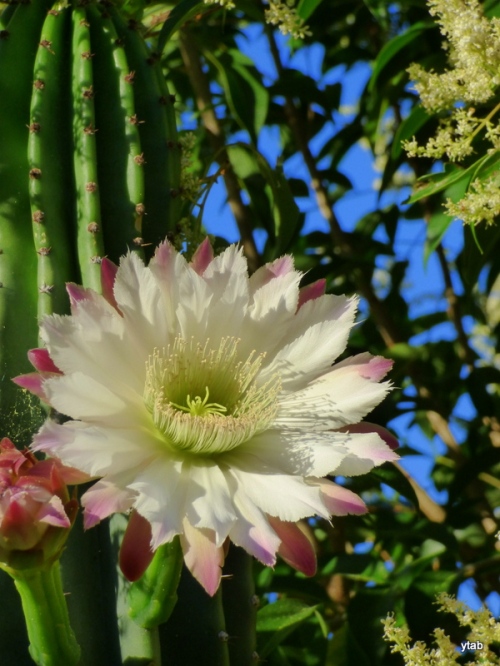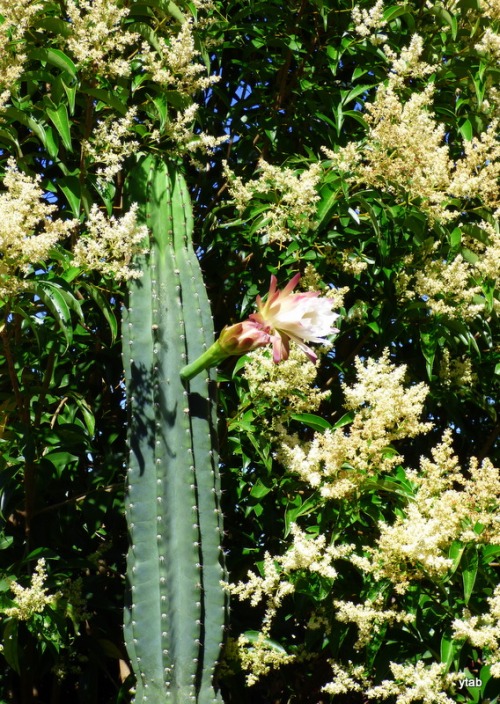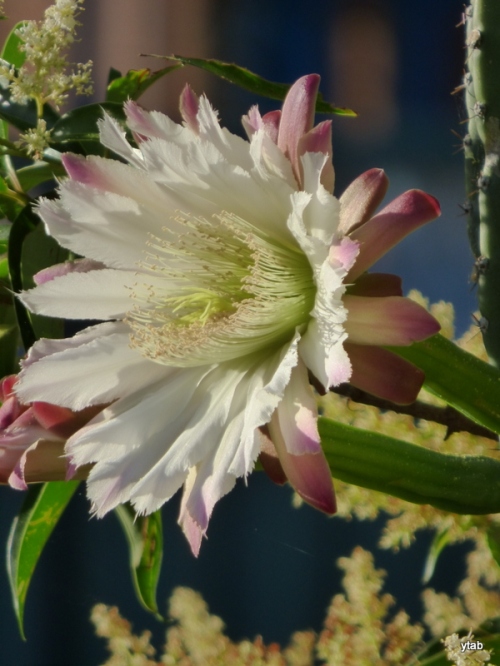I fully expected to be able to identify this cactus and dazzle you with the reason that it would bloom at this particular time of year, what insects or birds would be dependent on the nectar and pollen produced, blah, blah, blah.

But, I was brought to earth with a thud when I was unable to get Google to magically provide the information so I could impress you. So, I turn to you, my well-informed, intelligent knowledge base. Do you recognise this cactus, can you tell us its native country?
The single stem is very slim, well over 2 meters tall, and has to endure temperatures from -5 to +40 Celsius. It is an unusual plant to encounter here in Myrtleford, and is almost hidden in a corner of the communal garden.

The blossoms are so pretty and complex, and are held out from the main stem by what I’d call a branch, if this was a tree.

Two days after I happened to notice the first blossoms, they have faded and wilted. I hope some insects were able to partake of the exotic feast that was briefly offered.
So, which of you clever folks will be the first to tell us all about this wonder of nature?


Wow – amazing that this cactus blooms with such a beautiful flower! Thanks for sharing! I have a poetry blog here on WordPress and today’s poem is a lighthearted one about cacti in case you have time to look? Have a sunny day, Sam 🙂
LikeLiked by 1 person
And, that cactus is still blooming like crazy. The blossoms only last a short while, but then more have come out. I’ll go look at your blog, Samba.
LikeLike
Nature working its wonderful ways!
LikeLike
I have no idea what it is but I’m pretty sure it’s not from this planet.
LikeLiked by 1 person
It’s been narrowed down to a member of the cereus family. It’s been blooming it’s little head off, much to the delight of the native bees.
LikeLiked by 1 person
Love it
LikeLike
Isn’t it beautiful! There have been many more popping out.
LikeLike
Yes it is!
LikeLike
Pingback: Let’s get cereus * | Hello World
Beautiful! I have no idea what it’s called
LikeLike
Hmmm. You have lots of possibilities. I found Pilosocereus pachycladus, but it blooms at night. It is a native of Brazil.
LikeLike
I’m hoping you got an answer somewhere because I am of no use being decidedly botanically challenged. I could tell you something was a tree or a flower or possibly a tomato but that’s about it.
It’s noice, though. You know, different, unusual, noice.
LikeLiked by 1 person
Yes, it’s definitely noice! But, still a mystery.
LikeLiked by 1 person
We were walking in a well-known winter garden on a big estate a couple of weeks ago, when we noticed that the ancient wisteria, that drapes itself 40 foot high through some trees, was in bloom. We stared, amazed, because wisteria don’t bloom in December in England and the blooms were particularly big too. We were craning our necks and scratching our heads when our companion noticed a funny join between bloom and stalk and said, look they’re plastic (and they were)! Are you sure your cactus…?
LikeLiked by 1 person
LOL!!! I’ll go and check right now, Hilary. How disappointing to find your wisteria miracle wasn’t genuine.
LikeLike
IF your photos weren’t during the day, I would tell you they looked like a cereus bloom, but to the best of my knowledge, those all bloom at night.
LikeLike
And, if there was only one species of cactus, we wouldn’t be having this online conversation, Jeanne.
LikeLiked by 1 person
All I know is that the plant looks like ours, and the flower is very similar, but it blooms at night… oh, and the fruit is a ”cousin’ of dragon fruit, and it is delicious. Good luck finding the precise name!
LikeLiked by 1 person
There’s a group on Facebook devoted to cacti, I’ve asked (begged) to become a member. Then, I can post the photos to them and hope for a definitive answer.
LikeLiked by 1 person
Good luck with that! Do you have a local chapter of master gardeners? Sometimes they can be helpful, too.
LikeLiked by 1 person
The consensus on the Facebook group is that this a member of the cereus family, Jeanne. I’ll be watching for any fruit that may develop.
LikeLiked by 1 person
Our fruit gets sort of a dark rose color when ripe; it is round and basically smooth, about the size of a baseball. If you like dragon fruit, you’ll like this ‘cousin’ of it.
LikeLiked by 1 person
Magnificent beast
LikeLiked by 1 person
It is so intricate, and fleeting, Derrick.
LikeLiked by 1 person
I agree with Gerard. It’s not a tulip. It’s not a tulip! 😀 HA! 😛
I don’t know THAT cacti’s name, but I’ve seen similar ones in the SouthWest in the USA!
I know a lot of other cacti by name (not their scientific names)…Saguaro, Prickly Pear, Jumping Cactus, Yucca, Barrel, HedgeHog, Fish Hook…okay, I’ll stop listing now…I don’t want to become a thorn in your side! 😀
HUGS!!! 🙂
LikeLiked by 1 person
I don’t know if I would want to encounter a Jumping cactus. And now, I am off to see what they look like. Hugs back to you. 😇
LikeLiked by 1 person
They don’t really jump…but if you get close to them they do latch onto you quicker than other cacti. I have some jumping cactus horror stories.
LikeLike
Their real name is Cholla.
LikeLiked by 1 person
They’re truly evil things!
LikeLiked by 1 person
They’re monsters! https://youtu.be/DD6m8vmH2Lg
LikeLiked by 1 person
Yep, they are! 😦
LikeLiked by 1 person
I was just in Joshua Tree national forest in California a couple days ago and walked through an extensive cholla garden! Luckily, none jumped on me. We kept our distance. But your specimen is definitely not a cholla!
LikeLiked by 2 people
Thank goodness for that!
LikeLike
Ha! Oh, my comment was in reply to my first comment about cactus I do know the names of…like the Jumping Cactus being called a Cholla. I didn’t mean the pic of the cactus in the post is a cholla.
Sorry for the misunderstanding. You had to read my sequence of comments to understand what I meant.
🙂
HUGS!!! 🙂
LikeLiked by 1 person
By the way, a similar flower occurs on Epiphyllums, which are called the “orchids of the cactus world” or “orchid cactus” for short. Google them.
LikeLiked by 1 person
Okay, boss.
LikeLike
Succulents (and cacti) are quite interesting plants because they react to different environments and the stress that comes with those different environments. I have some Echeverias and Graptopetalums and blush all sorts of interesting colors when they are stressed from too much water, too little water, too much sun, too little sun, too hot, or too cold. They’ll turn pink, blue, orange, yellow, red…. and their blossoms will be different from those that would happen in their native habitats. That type of cactus is not native to Australia but it obviously likes living there; I would, too. The fact that they do different things when taken out of their native habitats means that it can be extraordinarily difficult to identify them based simply on pictures. Since it’s obviously not in its native environment, I went with the most common of the Mexican Fence Post cactus (also called “columnar cactus”) because the most common ones are the ones that get moved from place to place, and the most common ones are the ones that are easiest to grow, to breed, to bring to seed, and to adapt to a completely different environment. The only thing I can say with certainty based on pictures is that it is, indeed, a cactus……LOL
LikeLiked by 1 person
Give that man a pack of Snickers, folks! Cacti are definitely fascinating. I planted some in a small patio area up in tropical Queensland. They became like triffids, I was almost afraid to venture out in the dark …
LikeLike
It’s definitely a Sitonit Priklias 😉 ❤
LikeLiked by 2 people
Ouch! ❤
LikeLiked by 1 person
You have some wonderfully interesting botany over there in the down under! Wish things like that could spring up in my neighborhood!
LikeLiked by 1 person
I really love the native flora in Australia. Just thinking of the eucalypts, there are more than 700 species! They’re sort of like the cacti family in North and South America, I guess.
LikeLike
It is not a tulip, but that’s about as far as I can to make a guess.
LikeLiked by 2 people
Thanks, that was a great help, Gerard. 🙂
LikeLike
Russel might know.
LikeLike
Russel had plenty of suggestions, Darlene.
LikeLike
My husband likes to refer to me as a Bongong moth, because I come alive after dark. Maybe that is your nocturnal pollinator 🙂 They’d be migrating from the alps about now wouldn’t they?
LikeLiked by 1 person
Hmm, I never thought of that, nocturnal garrulous one. I’ll be looking out for the fruit, assuming they’ve been pollinated.
LikeLike
Bogong, not bongong. Predictive text!
LikeLiked by 1 person
Sure, blame predictive text! I do it all the time. 🙂
LikeLiked by 1 person
It’s quite beautiful, whatever it is. I’d go with Russel’s answer. It sounds like he knows what he’s talking about. 🙂 Good spotting, Yvonne.
LikeLiked by 1 person
Russel does know what he’s talking about, most times, et.
LikeLiked by 1 person
That is one of any possible species of the Mexican Fence Post cactus. Prior to genome mapping and such, there were many in the genera Backebergia, Lemaireocereus, Lophocereus, Marginatocereus, Mitrocereus, and Pterocereus. Genome mapping has brought them all together under the genus Pachycereus. My guess based just on those pictures is Pachycereus schottii, one of the most common. Each flower last about 24 hours but it depends on what time of the day the flower actually blooms. It also is called the “senita cactus” because it exhibits mutualism with the senita moth, the only nocturnal pollinator of the cactus. The moth relies on the cactus as a host for reproduction. Without this mutualism, both cactus and moth would be on the way out.
LikeLiked by 4 people
Wow, Rusty! The only cactus I found online that resembled mine was the Mexican Fence Post. The images all showed multiple stems, but I guess, considering that this specimen has wandered a few continents from where it belongs, it’s entitled to lose a few limbs!
Now, I have to find out if that moth exists here in Australia.
LikeLike
Even if your information doesn’t fit my cactus, that moth is fascinating! https://centralarizonacactus.org/assets/article/misc/CACSS_Article_Senita_Cactus_Missing_Moth_Tom_Gatz.PDF
LikeLike
The blossoms look like this, but the plant is far different: http://dendro.cnre.vt.edu/dendrology/syllabus/factsheet.cfm?ID=759
LikeLike
The blossoms on almost all of the Mexican Fence Post cacti look like that, in various iterations. Just because your plant is over there doesn’t mean that the moth is over there. These cacti can live for hundreds of years, but without the moth, they won’t be pollinated and thus won’t seed. However, as with most cacti and succulents, if a piece falls off and lands on the ground, where it touches the ground often grows new roots.
LikeLiked by 1 person
Not me, not an inkling, but it is lovely isn’t it?
LikeLiked by 1 person
I was so lucky to happen to glance at the almost hidden cactus the other morning, Mari. What a treat!
LikeLike
At first I thought it was a Neowerdermannia vorwerkii, but quickly realized it could be a Coleocephalocereus fluminensis or even a Weberbauerocereus cuzcoensis. I was going to ask a real expert, and not an amateur like me, but he got all prickly.
LikeLiked by 2 people
Have I mentioned lately that you’re funny, Bruce Almighty? Also, a little crazy? 🙂
LikeLiked by 1 person
Actually, the blossom is somewhat like that of the Weberbauerocereus cuzcoensis. So, now I have to add “clever” to my description of you, BA.
LikeLiked by 1 person
Lovely flower! I’ve seen smaller (or maybe younger) versions of this cactus, but I’ve no idea what they’re called.
LikeLiked by 1 person
Russel, in his comment above, gives a likely hypothesis. We might have different moths over here to do the pollinating.
LikeLike
Sounds like it’s been named, all right. After a bit, curiousity got too much for me and I went to the website of a local cacti seller. (The seller’s local, I mean, not the cacti.)
Anyway, the seller had photos of one simply called “Cereus” that flowered at night, and looked likely. From the number of names you’ve now got here ending in “-cereus” they sound like a big family!
LikeLiked by 1 person
Thanks for doing further detective work! They’re a huge family, aren’t they. I’ll keep an eye out for any fruit that might develop.
LikeLiked by 1 person
The genus Cereus was one of the first cactus genera to be described, way back in 1625. They didn’t have genome mapping back then. The whole world, flora and fauna, is being turned upside down with genome mapping. We’re discovering that just because two organisms look the same doesn’t mean they are related, and just because two organisms don’t look the same doesn’t mean they are not related. There is such a thing as “covergent evolution” and “divergent evolution” providing that one believes in evolution to begin with.
LikeLiked by 2 people
Hah! You and I are living, breathing proof of that, Rusty. Divergent, aren’t we??
LikeLike
It’s gorgeous! No idea what it is though, even though I spent many years living in the California desert. Everything I’ve read about Australia tells me you have very unusual plant life there.
Be sure to let us know when you find out. Love the flowers.
Isn’t it late spring there? That’s when cacti bloom in California’s deserts.
LikeLiked by 1 person
It’s summer time here. Heaven knows when and why that cactus was planted. It has been overwhelmed by plants that are more accustomed to our climate.
LikeLike
Depends on what cactus you’re talking about. Winter is aloe blooming season, and the aloes are magnificent. But who wants to go to the desert in the dead of winger? Cactus junkies like me, I guess.
LikeLiked by 1 person
Well I have no idea. But you didn’t say where the photo was taken.
LikeLiked by 1 person
It’s right here, in sunny downtown Myrtleford, John. I don’t think it’s a native of NE Victoria, somehow!
LikeLike